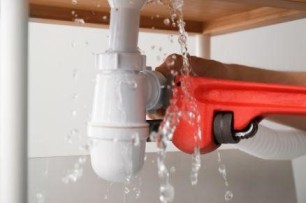General Insurance Blogs, Articles & Updates by - Magma HDI
Have us call you
- RENEW YOUR POLICY
- BUY NEW POLICY

What are the useful ways to deal with leakages at home
It is highly inconvenient to face water leakage in the home, be it a major one like a burst pipe or a steady drip from the tap. If not controlled in time, water leakage is expensive damage to deal with at home. It can waste gallons of water, but the maximum damage occurs if water seeps into the ceiling and destroys the walls and the paint job.
Our homes even face significant damage due to water leakage during monsoon. Heavy rainfall leads to leakages that get frustrating over time. This blog provides practical ways to deal with such leakages at home before calling an expert.
How to prevent a water leak:
Prevention is always better than cure. A few annual regular check-ups can prevent the hole in your pocket. Keeping this in mind, here are a few ways to check-up on your water pipes and supply to avoid massive repair work.
1. Keep your spidey senses on and feel around your home for areas with moisture or mould that might leak the plumbing. Inspect the most vulnerable parts of your home, including the roof and the walls, to check for any dampness.
2. The pipes exposed to the elements should be adequately insulated to prevent their material from eroding. Insulating material comes cheap, so this method is highly cost-effective.
3. A stopcock can stem the flow of the water supply around the house. Make sure to know the exact location of your stopcock to prevent flooding in the house due to a sudden burst pipe.
4. Install a water leak detection device at home.
Know how you can detect a leak:
To fix a water leak, you need to accept and inspect that it’s happening. The easiest way to check up on your plumbing is to check your water usage. If it has significantly increased, there might be a probability of a water leak. If this method seems too unsure for you, you can turn on the water supply without using water for an extended amount of time, say 02 to 03 hours and check if any water has been consumed. This is a sure sign that there is a leakage somewhere.
Ways to fix the water leak:
1. Turning off the water supply: The first step to prevent further damage to your home is to stop the water supply to the house and perform a thorough inspection.
2. Turning on the faucets to drain: If there is a significant leak in the house, the next best step is to drain all the water in the pipes and faucets. Start with the garden hose if you have one, and let the water run out.
3. Locate the problematic area: Go around the house checking for leakage, whether major or minor, and get it fixed.
4. Applying epoxy putty: Before this step, it is essential to wear latex gloves to protect your hands because hot epoxy putty can end up burning them. Epoxy putty is readily available in all hardware stores and can be a temporary fix to a leakage. Mound the epoxy putty well and apply a generous layer over the leaking pipe or tap.
Although epoxy putty is a helpful fix to many problems, it is ultimately beneficial if you can get a professional to fix this issue. If it’s a major plumbing problem, it might damage the ceiling or walls and can be extremely expensive to repair. Reliable house insurance India is always the best way to prevent these expenses from emptying your wallet. You cannot risk your belongings at the cost of water damage. Invest in the best house insurance and get advantages that will help you reap good returns on your investment.
Click HERE to know more about house insurance India.
Disclaimer: The information provided above is for illustrative purposes only. To get more details, please refer to policy wordings and prospectus before purchasing a policy.

Let’s understand how data and analytics are shaping the future of insurance
Data is considered to be the goldmine in today’s day and age. When appropriately utilised, it is one of the most critical resources that can provide great insights regarding several aspects of industries, consumers, products and services, and much more. The demand for data analysts, cloud computing, machine learning, and data science experts is very high among the top skills organisations for several critical roles related to data. This helps them understand the market and current data to curate future projections about their businesses and associated clients.
Data analytics is the most up-and-coming field across all sectors of industries. Companies are investing tons of money, resources, technology, and workforce in analysing relevant data across various platforms. Through this blog, let’s understand how data and analytics are shaping the future of insurance.
1. Understanding predictive analytics:
We all make predictions about specific things based on the facts we have in hand or the experience from similar situations we might have been through. Similarly, insurance companies use predictive analytics as an integral method to predict patterns and trajectories regarding various parameters. Predictive analysis is an umbrella term comprising multiple methods like data mining, statistical analysis, data configuration, predictive modelling, artificial intelligence, machine learning, etc. These techniques help the insurance companies generate reports that would then provide analysis and information about several risks, policies, consumer behaviour, and future revenue and business projections.
2. How to make sure that your “flight-risk” consumers stay:
Insurance companies try to identify consumers with immediate cancellation tendencies, high premium possibilities, or lower coverage. These potential customers require special attention and care from the insurers to convert or stay their customers.
Data and analytics reports can help insurance organisations identify the areas of concern that need attention and how the services can be improved from the consumers’ perspective. Advanced insights, reports, and patterns can help insurance companies analyse the pain points and friction between the organisations and the customers. This aids them in making the improvements and offering the best deals for their customers, which won’t be a loss-making situation for the company.
3. Personalisation is the key:
Customers want services and products tailored according to their demands and the trends in the current market. Making the services more consumer-focused helps the insurance companies eliminate the competition and gain more customers.
Personalisation is directly related to consumer loyalty which benefits organisations greatly in the long-term projections. Customer retention costs are pretty less compared to the expenses of customer acquisition. Fewer businesses and brands focus on customer retention and implement marketing gimmicks but don’t get desired results. Personalisation is the answer to your customer retention and consumer loyalty equation here. Data analytics help you identify the red flags when rating the customer satisfaction provided by your insurance company. This allows the insurers to understand the market trends, how consumer demands are changing, and how they can bring their services up to the mark. The red flags can turn green based on the current reports, the future projections, and the options and techniques which can be implemented to achieve the targets and results.
Other ways in which data and analytics are revolutionising the insurance market include fraud detection, risk and mitigation measures, managing workforces, determining premiums and dealing with insurance claims, and much more.
Customers are advised to purchase GENERAL INSURANCE to ensure their financial assets are protected, and they can earn some profit even during financial losses. You can explore all your options and determine a general insurance company with high market credibility, attractive premiums, and an excellent claim settlement ratio.
Click HERE to know more about how you can find your ideal general insurance company.
Disclaimer: The information provided above is for illustrative purposes only. To get more details, please refer to policy wordings and prospectus before purchasing a policy.

Complete guide on using the residential apartment for commercial use
Using your private property for commercial purposes may seem like a fantastic way to grow your business if you have an office at home. It has been common practice to convert a residential property for commercial use to increase income. However, housing societies usually don't appreciate it when a whole residential unit is used for business.
Owners are permitted to use a portion of the property for commercial purposes. However, there are several restrictions and legislations that you must be aware of to use your apartment as an office space. In addition, getting the best home insurance policy in India can help you save money when you rent or buy a business space.
Is there a regulation in India that governs how residential property is used and rented out?
Across Indian cities, the zoning law is enacted by the local municipal government or authorities. It governs the use and allocation of land to different services and purposes. According to the legislation, commercial activity should be kept out of residential areas for the benefit of residents and to encourage the growth of the proper commercial regions.
What exactly does the law state?
It is essential to note that different states have different levels of leniency when it comes to commercial use. In some states, professional service providers such as doctors, lawyers, and chartered accountants are permitted to use up to 30% of their homes for business purposes. But in other states, they are not.
Before converting a residential property into commercial space, ensure that it's permitted. You must get clearance from the local housing authority. Once a property has been officially considered for retail space, it will be regarded as such for all purposes, including paying a higher property tax rate than a residential property.
Things to keep in mind when turning a residential property into a place of work.
Commercial activity is any activity related to the buying and selling of merchandise. Most housing societies allow the operation of businesses such as professions, services, and the teaching of specific art forms.
Activities such as yoga classes, tuition classes, or the services of chartered accountants, doctors, and lawyers are not considered as commercial activities. Commercial activity within residential properties may not be authorised due to security concerns as they create a significant traffic hazard for the neighbourhood.
For those who are willing to use their home for commercial purposes, here are a few considerations to bear in mind:
1. Before making an application, make sure you know exactly how much space you'll need and what kind of business you want to start.
2. Obtain a permit to operate a business from the local municipality.
3. Ensure that your clients are not using communal spaces such as the parking lot or other amenities.
4. If your home is turned into a business, you may have to pay more property taxes.
Many people find that running a business from home is an excellent way to save money since the cost of rent and transportation are significantly reduced.
Before starting a business in a residential space, get approval from the housing society, local councils, and zoning authorities. Also, get the best home insurance policy in India so that you can keep your apartment safe as you turn it into a business.
Click HERE to get the best home insurance policy in India.
Disclaimer: The information provided above is for illustrative purposes only. To get more details, please refer to policy wordings and prospectus before purchasing a policy.

Best tips to apply adhesive wallpaper for better results
Owning your own home is an extensive process. You explore hundreds of houses, put a lot of thought into remodelling and painting, and invest a ton of money in furniture and appliances that match your home's feel.
The walls of your house hugely contribute to the decoration and the aesthetic you want to create. They bring out the vibe you want your home to radiate. And while you can do many things to decorate your walls like hanging art, using textured paints and patterns, adorning them with home decor items, etc., a recent trend of adhesive wallpapers has garnered people's attention.
Adhesive wallpapers are easily accessible, come in various designs and colours and embellish the decoration of your home within a friendly budget. But applying these wallpapers can be a tricky and messy process.
This blog will discuss the best tips to use adhesive wallpaper for better results.
1. Wipe your walls:
It is good to clean the walls first with a microfiber cloth before applying the adhesive wallpaper. This will remove the dust on your walls and make the surface smoother for better application.
2. Move your furniture:
For correct measurement and easy installation of adhesive wallpapers, move all the furniture, switch covers and other removable outlets. You should make sufficient comfortable space to conduct the wallpaper work efficiently.
3. Layout:
Planning and jotting down the layout makes it easy to understand the space and the amount of wallpaper required to cover the area. You can either start by measuring the length and width of the walls and stick the stripes from left to right or by beginning at the centre, marking the left and right extremes and working your way, one direction at a time.
4. Check:
Once you stick the outline stripes, inspect the walls to check whether they are aligned and distanced equally. Overlapping might result in messy wall decoration.
5. Paint your walls:
Smooth wall paint works well with adhesive wallpapers if you apply satin-type primers. Matte paint becomes challenging due to its firm texture, thus making it difficult for adhesive wallpapers to stick.
6. Tools:
Using the right tools will help you in making the process of applying adhesive wallpapers easy. You can use a cutting knife to cut tricky corners and edges and a ruler to smoothen the rough edges and measure the intricate spots. You can also use a needle for popping the bubbles while sticking the wallpaper.
7. Peel properly:
Peeling the wallpaper must be done correctly. If you peel off the back paper in haste, you risk tearing the wallpaper and messing up the whole pattern and decoration. You can start from the top and work your way down slowly as you apply. Maintaining a steady flow of action and focusing on just your movement is essential.
Now that we have discussed the best tips to apply adhesive wallpaper for a better feel and appearance, it is also necessary to think about the safety of your house. Protect your home against unprecedented situations like fire, theft, or natural disasters, and avoid unwanted monetary stress. You can explore different options and choose the best house insurance in India, which caters to your needs and offers exclusive benefits.
Click HERE to know more about house insurance in India.
Disclaimer: The information provided above is for illustrative purposes only. To get more details, please refer to policy wordings and prospectus before purchasing a policy.


